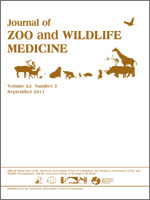Two pilot trials and one study in a closely related grebe species suggest that Western grebes (Aechmophorus occidentalis) will not tolerate intracoelomic transmitter implantation with percutaneous antennae and often die within days of surgery. Wild Western grebes (n = 21) were captured to evaluate a modified surgical technique. Seven birds were surgically implanted with intracoelomic transmitters with percutaneous antennae by using the modified technique (transmitter group), 7 received the same surgery without transmitter implantation (celiotomy group), and 7 served as controls (only undergoing anesthesia). Modifications included laterally offsetting the body wall incision from the skin incision, application of absorbable cyanoacrylate tissue glue to the subcutaneous space between the body wall and skin incisions, application of a waterproof sealant to the skin incision after suture closure, and application of a piece of porcine small intestine submucosa to the antenna egress. Survival did not differ among the 3 groups with 7 of 7 control, 6 of 7 celiotomy, and 6 of 7 transmitter birds surviving the 9-day study. Experimental birds were euthanized at the end of the study, and postmortem findings indicated normal healing. Significant differences in plasma chemistry or immune function were not detected among the 3 groups, and only minor differences were detected in red blood cell indices and plasma proteins. After surgery, the birds in the transmitter group spent more time preening tail feathers than those in the control and celiotomy groups. These results demonstrate that, in a captive situation, celiotomy and intracoelomic transmitter implantation caused minimal detectable homeostatic disturbance in this species and that Western grebes can survive implantation of intracoelomic transmitters with percutaneous antennae. It remains to be determined what potential this modified surgical procedure has to improve postoperative survival of Western grebes that are intracelomically implanted with transmitters with percutaneous antennae and released into the wild.
How to translate text using browser tools
1 September 2011
Short-Term Survival and Effects of Transmitter Implantation Into Western Grebes Using a Modified Surgical Procedure
Joseph K Gaydos,
J. Gregory Massey,
Daniel M Mulcahy,
Lori A Gaskins,
David Nysewander,
Joseph Evenson,
Paul B Siegel,
Michael H Ziccardi
ACCESS THE FULL ARTICLE
Aechmophorus occidentalis
celiotomy
implantation
telemetry
Transmitter
Western Grebe





